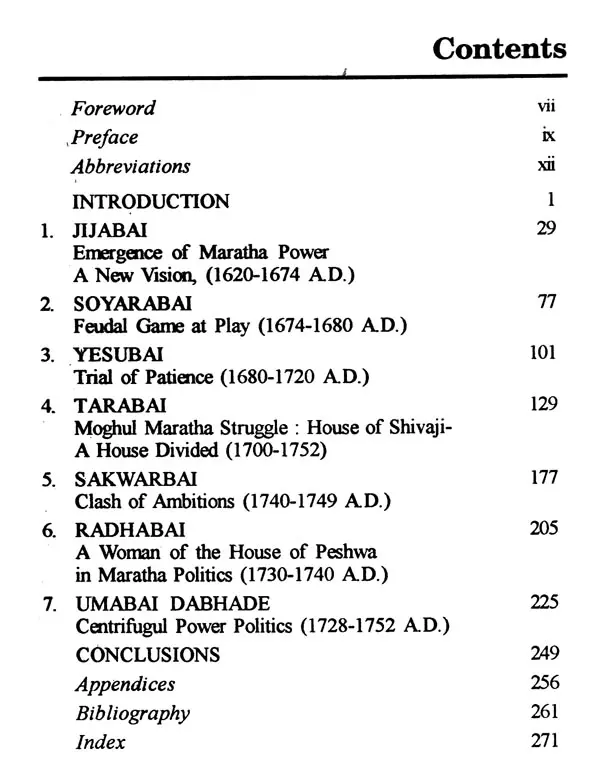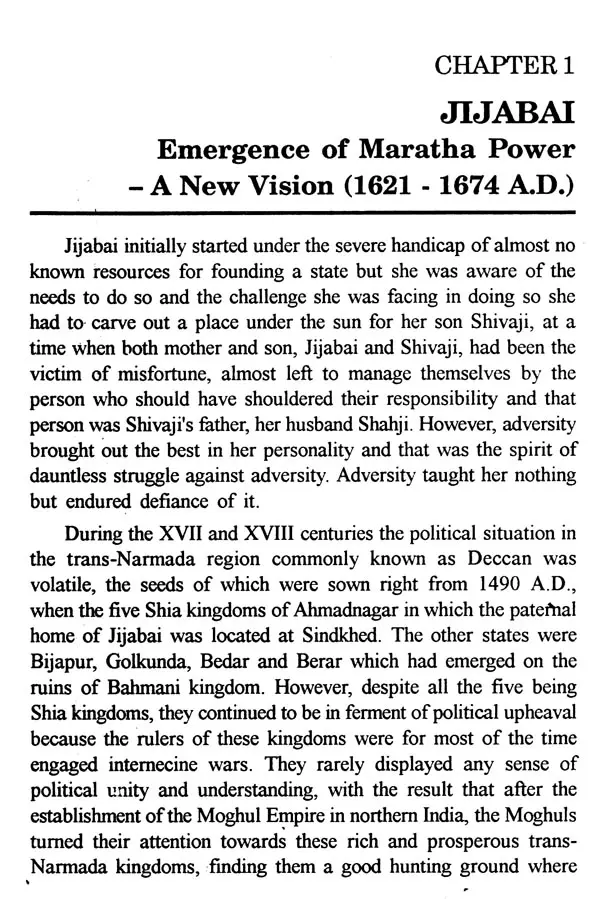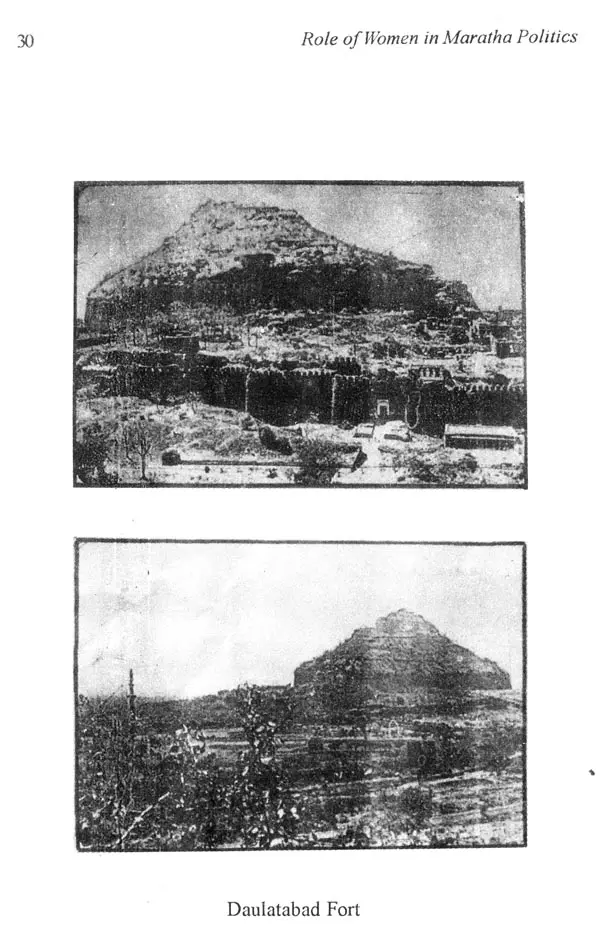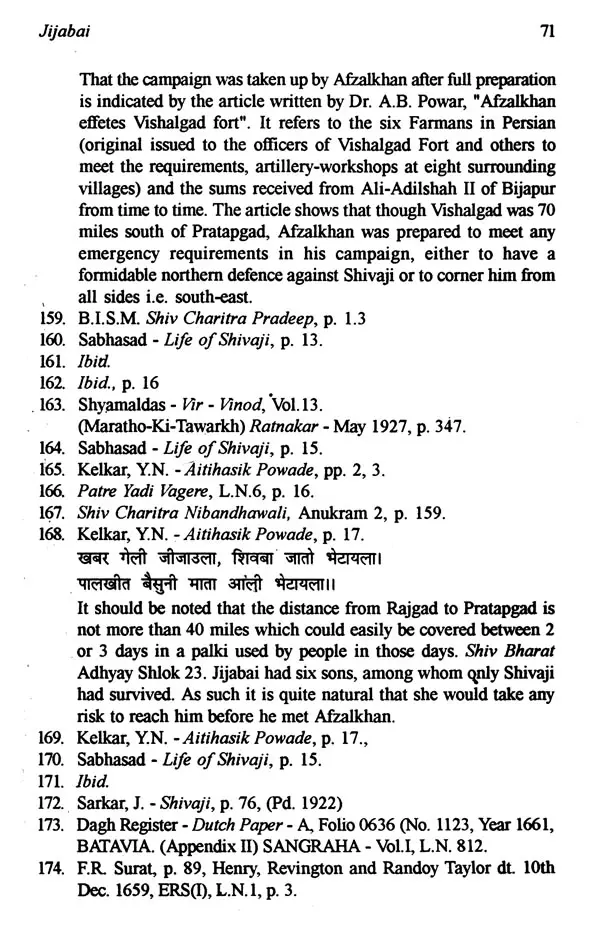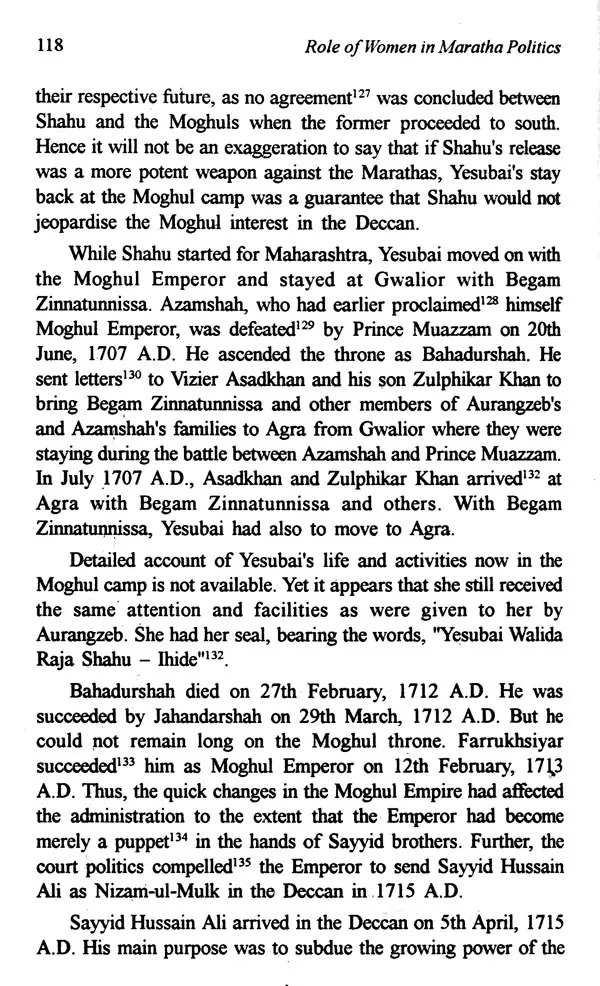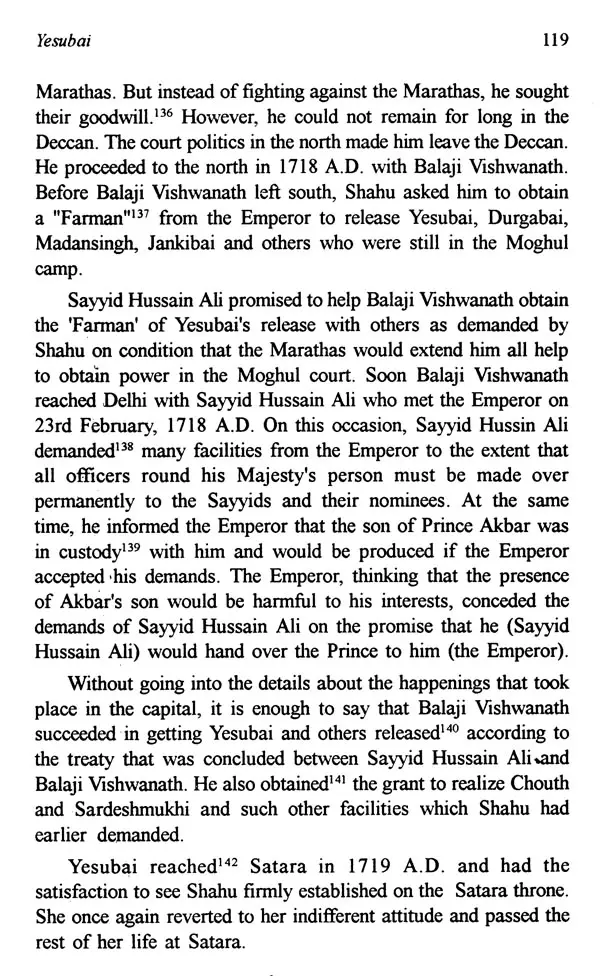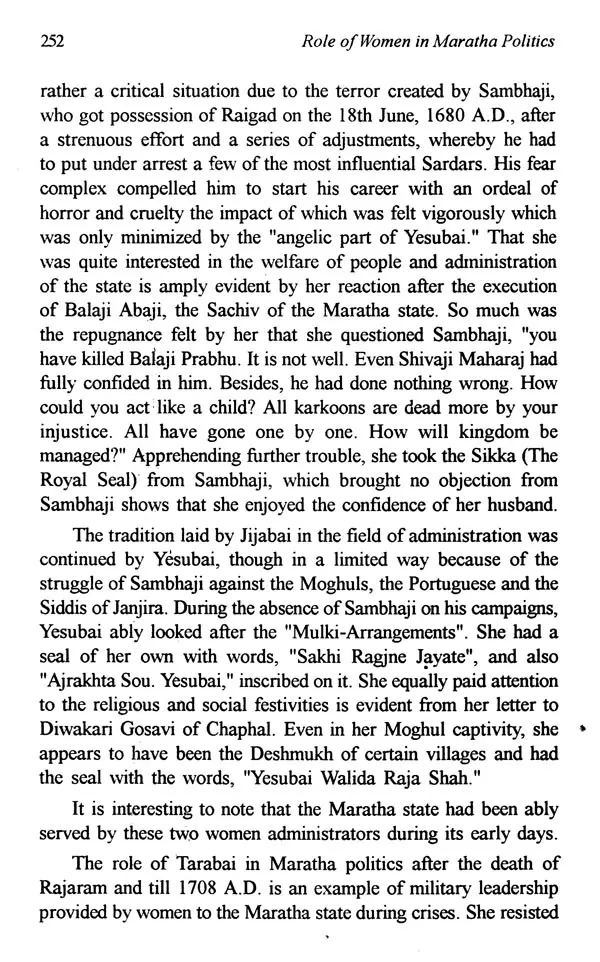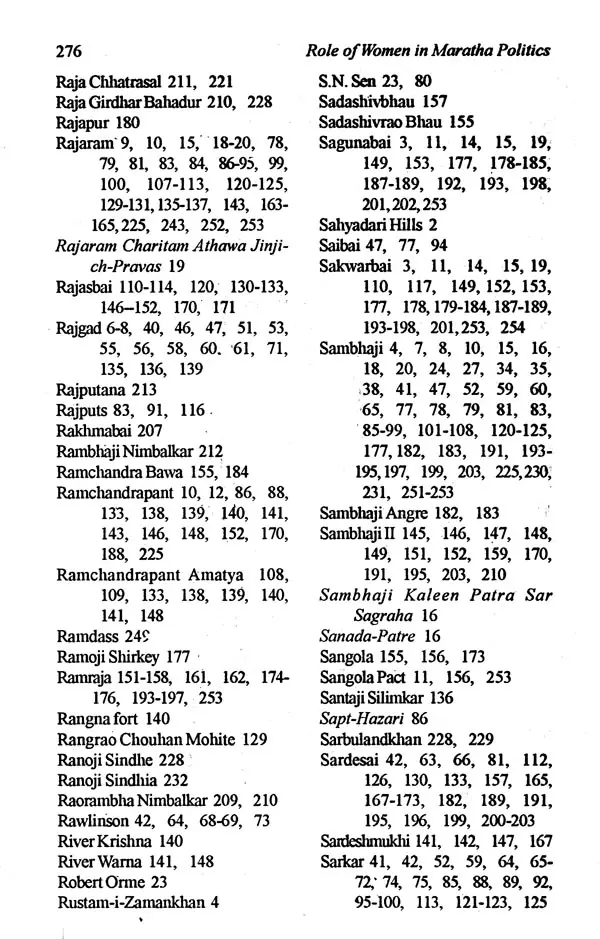
Role of Women in Maratha Politics (1620-1752 A.D.)
Book Specification
| Item Code: | UAG210 |
| Author: | Sushila Vaidya |
| Publisher: | Sharada Publishing House, Delhi |
| Language: | English |
| Edition: | 2000 |
| ISBN: | 8185616671 |
| Pages: | 288 (4 B/w Illustrations) |
| Cover: | HARDCOVER |
| Other Details | 9.00 X 6.00 inch |
| Weight | 560 gm |
Book Description
In the galaxy of such women nine outstanding personalities have been included; seven of them belonged to the Bhonsle family who were directly connected with the rulers of the Maratha Confederacy. They were-Jijabai (1620-74 AD.); Soyarabai (1674-80); Yesubai (1689- 1719 A.D.); Tarabai (1700-52 A.D.); Sakwarbai, Sagunabai and Virubai the queens and mistress of King Shahu respectively. The other women who figure in this work are Radhabai (1700- 52 A.D.); wife of Balaji Vishwanath and mother of Peshwa Bajirao; and Umabai Dabhade (1728-52 A.D.) wife of Khanderao Dabhade, Senapati, of Sliahu.
The most redeeming feature 'of Maratha women was their service to the cause of their family and the state which may be called exemplary but no attempt has been made to present a total picture of their activities in the Maratha political panorama during this period (1620-1752 AD.' which have been highlighted in this work.
Dr. Vaidya's book would prove a valuable source material for all centers of Women Studies and Research in the Universities and colleges.
She hails from the family of scholars and patriots with a thoroughly religious background. Her mother in her own way was well versed in the then Women .activities of Calcutta of her times. Her grand father wrote history of medieval India in Persian in 1818 AD. which may be traced as the inspiring source of Dr. Vaidya's love for history- a subject which she taught for many years. Her research on the Maratha history during her tenure as a teacher of teachers was of very high order. Dr. Vaidya is known for her in-depth study, of woman contribution in the history of the Marathas. Her involvement in the study of women naturally made her study, the general status of women in India and their role in the making of this great land of ours.
She had been regularly contributing in the . research journals and her research paper- 'Ramraja-Satara Court Politics-1745-1752' earned her great appreciation by historians of eminence including Dr. Moraes at Patiala, seminar of Indian History Congress-1967, reprinted in lihas , Journal of the Andhra Pradesh Archives, Vol. 1, No.2, January-June, 1974.
The present volume "Role of Women in Maratha Politics-1620-1752 AD.", .is her lifelong work in the area of woman studies-A branch which has been lately understood as important by the University Grant Commission.
Dr. Ku. Sushila Vaidya has very painstakingly gathered information about these able women from the historical documents and other materials. Dr. Sushila Vaidya has left no paper unread to collect this. information about the period from 1620 to 1752 A.D. For this purpose she had transplanted herself to Maharashtra from Jabalpur in Madhya Pradesh to which she originally belongs.
She zealously studied originally documents in various languages such as Persian, Marathi, English, Sanskrit, Deccani Urdu, etc. She also derived great benefit from the great stalwarts of history such as Late Dr. R.P. Tripathi, Dr. Datto Varnan Potdar, Dr. G.H. Khare, and N.K. Joshi. All her persistent efforts have borne a , delicious fruit in the form of this book.
It is indeed a difficult task to prepare a systematic account of the abilities and achievements of Jijabai, mother of Shivaji Maharaj, and her two daughters-in-law, Tarabai and Yesubai, but Dr. Sushila Vaidya has studied each document with relevant references in great detail and depth. It has resulted in this excellent political biographies of these three Royal Maratha Women. Dr. Sushila Vaidya's perseverance and writing skill are worthy of great appreciation.
Similarly, she has written in highly informative manner about the political lives of Radhabai Peshwa, Umabai Dabhade, Sakwarbai Bhonsle and others. The Marathas, though poorly equipped with only their horses could establish their strong rein over areas from Kaveri to the Attack (North-West frontier) only because their velour was backed by the strong power of their inspiring, intelligent and capable wives. Every generation must take note of the effective and dynamic power of the women.
That is why, I strongly feel that Dr. Sushila Vaidya's book should be translated in every Indian language. This book deserves an active and respectful support by every Indian University. Presently, the movement for women's liberation is very active all over India and if that movement has to succeed, literature similar to Dr. Sushila Vaidya's book must make a deep impression on the mind of every woman also every man, so great is the value and importance of this book.
The subject presents an analytical study of the characteristic of the Maratha women - their activities concerned with the problems of state-craft, their victories and failures, the handicaps and limitations under which these women had to rally the available resources in men and material in the face of heavy odds of the Muslim and Mosques interferences and their determination to subjugate the southern powers which they could never achieve even by the most astute of Moghul Emperor, Aurangzeb who had the vigor, tenacity and a will to devour Deccan for which he tried incessantly for about twenty-five years of his life without success, circumstantially, this had brought in the decline of the Moghul Power in north as well.
The galaxy of such women nine outstanding personalities " have been included, seven of them belonged to the Bhonsle family who were directly connected with the rulers of the Maratha Confederacy. They were-Jijabai (1620-74 A.D.); Soyarabai (1674-80); Yesubai (1689-1719 A.D.); Tarabai (1700-52 A.D.); Sakwarbai, Sagunabai and Virubai the queens and mistress of King Shahu respectively. They bore prominence because of their activities concerned with the royalty and the problem of succession. There were others also who participated in and influenced the Maratha politics, prominent amongst them were two, namely Radhabai (1700-52 A.D.); wife of Balaji Vishwanath and mother of Peshwa Bajirao; and Umabai Dabhade (1728-52 A.D.) wife of Khanderao Dabhade, Senapati of Shahu. Their role stands on different footing, while Radhabai's activities has drawn scant attention of the historians, no methodical study of the role of Umabai Dabhade has been undertaken so far. Hence, an attempt has been made to evaluate their historical worth and material for this has been drawn from sources like, "Purandara Daftar," and "Senapati Dabhade Daftar."
The most redeeming feature of Maratha women was their service to the cause of their family and the state which may be called exemplary but no attempt has been made to present a total picture of their activities in the Maratha political panorama during this period (1620-1752 A.D.).
As for the sources, an attempt has been made to examine and utilize all the' available material both original and secondary in Sanskrit, Marathi, English, Canaries and Persian-their translation referred to in the chapter Introduction (Sources and their Evaluation). These sources are listed in the Bibliography, appended at the end of this study.
. The seventeenth century Maratha polity and society had been shaped by twin forces of Maratha Cultural renaissance and the desire to found a Hindu State on the ruins of the crumbling power of the Shia kingdoms of Ahmadnagar, Bijapur and Golkunda. An interesting feature of this phenomenon was that these kingdoms were 'being propped up both by the Muslims and Maratha Sardars.
Hence, an attempt to carve out an independent State in opposition to these kingdoms was bound to arouse hostility of both the Muslims and Maratha Sardars who looked at the new rising centre of the Maratha power as a threat to their position in the court politics of their respective Shia kingdoms and their political distance with the result that many of the Maratha Sardars serving the Shia kingdoms were not the supporters of the new emerging Maratha State.
Under these circumstances, Jijabai and Shivaji, the founder of the "Independent Maratha State" had to look to new pastures for their sustenance, support and strength. This made the founder of the Maratha State not only totally those Sardars who were amiable to this rising State but also to obtain support of the grass root level for this cause. Fresh ground was to be broken and new support base was to be created for which he turned towards the hardy people of Sahyadari Hills (Maval). Shivaji converted them into his ardent followers. This was all the more needed to give a firm foundation to the project of Jijabai, the guiding spirit for establishing a "Hindu State" with the aim of protecting the women and religion. This was no vision of a fundamentalist or of an obscurantist. She was opposed to any type of tyranny with the result that the Muslims living in "Swarajya" also enjoyed the same place of respect as was being enjoyed by the "Hindus". She was opposed to religious oppression but was not against the believers of any religion. Shivaji's "Hindu-Pad-Padshahi" never aimed to annihilate others, who were non-Hindus, but in fact "Hindu-Pad- Padshahi" was for all who lived within it. This concept is not the replacement of one tyranny by perpetuating another tyranny.
Jijabai initially started under severe handicap of having almost no known resources for founding such a state to carve out a place for her son Shivaji, under the Sun. Moreover, at that time both mother and son were victims of misfortune, as the person who should have shouldered their responsibility had to leave them and that person was Shivaji's father Shahji in 1636 A.D. However, adversity brought out the best in her personality and the spirit of dauntless struggle against adversity. Adversity taught the mother and the son nothing but endured defiance of it.
Book's Contents and Sample Pages

